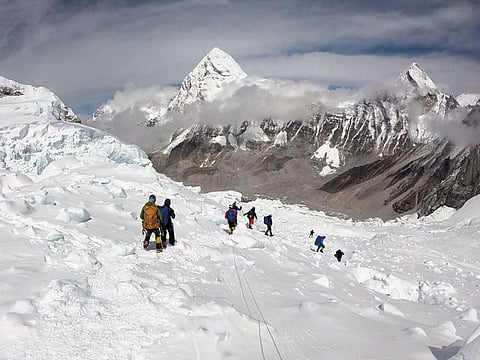‘I did say that May 22 looked too dangerous to climb — but nobody listened’
Everest operators have been warning for years that inexperience will exact a heavy toll

Also In This Package
Dubai: Mount Everest remains the pinnacle of every climber’s dream and immediately conjures a collage of magnificent memories — but becoming a part of a fatal traffic jam is certainly not among them.
Yet, 44-year-old British climber Robin Haynes died on Saturday on Mount Everest — bringing to 10 the total death toll this season on the world’s largest peak. A surge of trekkers waiting to get down from the summit on May 22 was blamed for the spike in deaths.
“I have seen so many climbing seasons, but never something as drastic as this,” Dawa Steven Sherpa, a Nepalese Sherpa entrepreneur who has scaled Mount Everest twice, told Gulf News on Saturday.
“However, I don’t think such a high number of fatalities will stop people from attempting to climb in the next season,” Sherpa said over the phone from Kathmandu — where he has just returned back from the mountain.
Such a disaster was bound to happen, since 381 permits have been issued this season and more than 800 people are attempting to climb Mount Everest in a few windows this season from the Nepalese side. That’s a fatal recipe for disaster.

Veteran operators of Everest have been warning for years that inexperience among both climbers and rapidly proliferating operators could lead to completely avoidable fatalities.
“With the number of operators growing by the day, we will end up with more fatalities on the mountain until the operators mature,” Russell Brice, owner of Himalayan Expedition, told Gulf News in an earlier interview.
Brice, one of the most well known faces of Himalayan experiences, has been taking people up Everest since 1994 and his company is the biggest Everest operator in Nepal.
“Such a disaster was bound to happen, since 381 permits have been issued this season and more than 800 people are attempting to climb Mount Everest in a few windows this season from the Nepalese side. That’s a fatal recipe for disaster,” said Percy Fernandez, an avid mountaineer based in Dubai, who was the expedition photographer of the 2013 NCC Everest expedition.
The final leg of the journey to the summit of Everest is a tricky and treacherous affair, and experts say the unprecedented rush has been triggered by a combination of good weather and a mushrooming number of operators — not all of whom are scrupulous about safety.
The result: a long file of trekkers waiting in queue on the descent, with queues stretching beyond several hours.
On how the unprecedented number of fatalities can be stopped, Sherpa said: “Several solutions are easily available. We work really hard along with other top members of the climbing community in Nepal to gather the data and schedules every season and try to spread out the number of climbers every day. This strategy worked very well in the past, but this year because the weather forecast went out of whack, everyone panicked to get a good window on the same day. I did say that the 22nd looked very very dangerous to climb, but nobody listened.”
According to Fernandez, most of the climbers have died because of exhaustion. “On their way down, they ran out of oxygen because of the traffic jam,” he told Gulf News.
I have seen so many climbing seasons, but never something as drastic as this. However, I don’t think such a high number of fatalities will stop people from attempting to climb in the next season.

However, with the current rush to make the most of the sliver of a window, the results could be hardly any different.
“Because everyone has only those few windows for summiting, it’s hard not to get caught in the traffic jam. Reliable operators leave no stone unturned... the not so ones are where people lose their lives,” said Fernandez, who is also the chairperson of the School of Media and Communication at the Manipal Academy of Higher Education in Dubai.
What’s the solution so that this doesn’t recur the next season?
“One potential solution is for the Nepal government to give us permission to fly the ropes up to the summit on helicopters very early in the season,” said Sherpa.
“Usually the permission comes in too late — if they are issued early enough, it will take the pressure off the logistics in a big way. A lot of other very simple things can also change the situation — such as better communication and coordination among teams about the dates and number of people climbing,” he said.
While operators like Asian Trekking led by Sherpa and others have been trying to find a way out, it is unlikely the Nepal government will put a cap on the number of climbers since the permits give them a revenue windfall, said Fernandez.
“The permits also give climbing Sherpas an opportunity to earn in these two months. Recently western climbers have appealed for a lot system like the London or New York marathon but I don’t think the solution lies there,” he said.
Sign up for the Daily Briefing
Get the latest news and updates straight to your inbox




